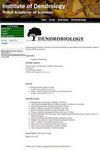五针松人工杂交及其杂交频率
IF 1.8
4区 农林科学
Q2 FORESTRY
引用次数: 7
摘要
针叶树的种间杂交能力是众所周知的。五针松属五叶松在生态系统中起着重要的作用,具有重要的经济意义。在自然界或受控授粉条件下发生的种间杂交表明,生殖隔离是相对的,表现程度不同。控制授粉使我们能够收集有关生殖相容性的知识,并为育种工作提供有价值的材料。五针松人工杂交起初纯粹是为了提高抗水疱锈病的能力,后来有人建议在分类时应考虑到物种的杂交能力。以西伯利亚松(Pinus sibirica)、红松(P. koraiensis)和天然西伯利亚松×矮叶松(P. sibirica × P. pumila)杂交无性系为母树,利用11种五针松和4种五针松杂交植物的花粉进行了对照授粉。首次获得了koraiensis × P. armandii、koraiensis × P. monticola、koraiensis × P. sibirica、P. sibirica × P. ayacahuite、P. sibirica × P. armandii和P. sibirica × P. wallichiana的种间杂交以及部分杂交组合的种子。根据研究结果和现有的杂交性资料,我们得出结论,五针松不存在完全的生殖隔离,并且证实了种间基因流动在本节中是常见的。本文章由计算机程序翻译,如有差异,请以英文原文为准。
Artificial crosses and hybridization frequency in five-needle pines
The capability of conifers for interspecific hybridization is well known. Five-needle pines from the section Quinquefoliae of the subgenus Strobus play an important role in ecosystems and have great economic significance. Interspecific hybridization that occurred in nature or under controlled pollination suggests that reproductive isolation is relative, being expressed to different degrees. Controlled pollination allows us to gather knowledge about reproductive compatibility and provides valuable material for breeding work. Artificial crosses of five-needle pines began with a purely practical purpose to increase blister rust resistance and it was subsequently suggested that species crossability should be taken into account in their classification. We carried out a number of controlled pollinations using Pinus sibirica, P. koraiensis and natural P. sibirica × P. pumila hybrid clones as maternal trees along with pollen of 11 species and four hybrids of the five-needle pines. For the first time, seeds were obtained from the interspecific crosses P. koraiensis × P. armandii, P. koraiensis × P. monticola, P. koraiensis × P. sibirica, P. sibirica × P. ayacahuite, P. sibirica × P. armandii, and P. sibirica × P. wallichiana, as well as from some combinations with hybrids. Based on the results and available information on the crossability of the species, we concluded that complete reproductive isolation does not exist among five-needle pines, and confirmed that interspecific gene flow is common in this section.
求助全文
通过发布文献求助,成功后即可免费获取论文全文。
去求助
来源期刊

Dendrobiology
农林科学-林学
CiteScore
2.20
自引率
11.10%
发文量
17
审稿时长
>12 weeks
期刊介绍:
Dendrobiology publishes original research articles and review articles related to the biology of trees and shrubs.
 求助内容:
求助内容: 应助结果提醒方式:
应助结果提醒方式:


